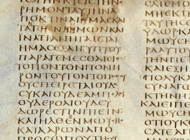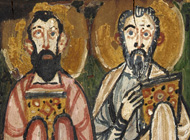|
In 303 C.E., during the "Great Persecution" of Christians, the Roman emperor Diocletian ordered the destruction of Christian books. But only ten years later—following his vision of the Cross and subsequent victory in battle—Emperor Constantine granted religious toleration throughout the Western Empire. This toleration was extended in 324, when he united the empire's two halves, establishing a new "Rome" at Constantinople.
Constantine (died 337) and his successors convened councils to determine the nature of Christian belief; many churches were founded, all requiring collections of Christian texts. In 332 C.E., for example, Constantine commissioned fifty copies of Christian scriptures for his foundations from the biblical scholar Eusebius of Caesarea (circa 260—339). Christian writings began to be gathered together in large, expensive books, appropriate for use in prestigious surroundings.
Later in the fourth century, the Roman Empire adopted Christianity as the state religion. This gave further impetus to the production of the biblical "canon," that is, a fixed list of books understood to have unique status by virtue of divine inspiration. Before this time, a great number of texts had been in circulation, bearing out the words of Saint Luke that "many" were writing about Jesus. Some texts came to be rejected due to dubious authenticity or association with radical sects. More of these have come to light in modern times, including, most recently, the Gospel of Judas.
From Greek to Latin
The earliest complete Christian bibles—Codex Sinaiticus, Codex Vaticanus, and Codex Alexandrinus—were written in Greek and date from the fourth to fifth centuries. They were powerful symbols for Christians, physically expressing the unity of the Old and New Testaments, but they were rare even in their own time, being impractical to use and expensive to produce.
Codex Sinaiticus is thought by some scholars to have been made in Caesarea (in modern Israel) as early as the fourth century. This area hosted much of the research and writing conducted by two influential Early Christian scholars: Saint Jerome (circa 347–419/20) and Bishop Eusebius (circa 260–339), who devised a system of canon tables that allowed comparisons across the gospels. Although Codex Sinaiticus cannot be directly connected to either man, it certainly flourished in the same fertile intellectual soil.
Christian scriptures usually circulated in the form of smaller collections of gospels or epistles. Early gospelbooks include the Harley Gospels, an example of Jerome's "Vulgate" edition of the Bible—so named because it was in the common (vulgar) language of the day, Latin, the basis of the emerging "Romance" languages.

|
 |
Click on an image for details:

Codex Sinaiticus

Right cover of the Washington Ms

The Gospel of St. Thomas (Logia Iesou)
|